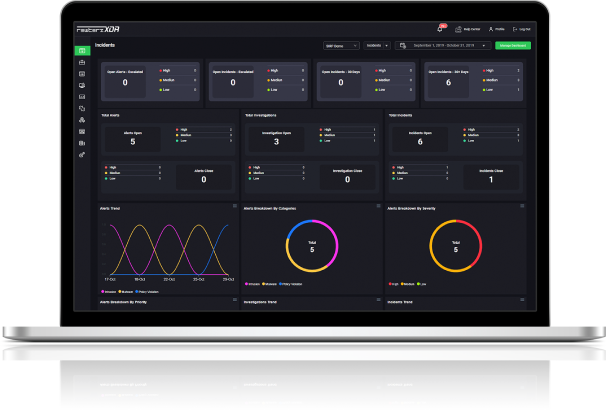

Rewterz Threat Alert – Hive Ransomware – Active IOCs
July 18, 2022
Rewterz Threat Advisory – CVE-2022-22445 – IBM Security Bulletin Vulnerability
July 19, 2022
Rewterz Threat Alert – Hive Ransomware – Active IOCs
July 18, 2022
Rewterz Threat Advisory – CVE-2022-22445 – IBM Security Bulletin Vulnerability
July 19, 2022Severity
High
Analysis Summary
CVE-2022-30205 CVSS:6.6
Microsoft Windows could allow a remote authenticated attacker to gain elevated privileges on the system. By sending a specially-crafted request, an authenticated attacker could exploit this vulnerability to execute arbitrary code with higher privileges.
CVE-2022-30203 CVSS:7.4
Microsoft Windows could allow a local authenticated attacker to bypass security restrictions, caused by a flaw in Boot Manager component. An attacker could exploit this vulnerability to bypass security features and cause an impact on confidentiality, integrity and availability.
CVE-2022-30202 CVSS:7
Microsoft Windows could allow a local authenticated attacker to gain elevated privileges on the system, caused by a flaw in the Advanced Local Procedure Call component. By executing a specially-crafted program, an authenticated attacker could exploit this vulnerability to execute arbitrary code with higher privileges.
CVE-2022-22050 CVSS:7.8
Microsoft Windows could allow a local authenticated attacker to gain elevated privileges on the system, caused by a flaw in the Fax Service. By executing a specially-crafted program, an authenticated attacker could exploit this vulnerability to execute arbitrary code with higher privileges.
CVE-2022-22049 CVSS:7.8
Microsoft Windows could allow a local authenticated attacker to gain elevated privileges on the system, caused by a flaw in the Client/Server Runtime Subsystem Service. By executing a specially-crafted program, an authenticated attacker could exploit this vulnerability to execute arbitrary code with higher privileges.
CVE-2022-22047 CVSS:7.8
Microsoft Windows could allow a local authenticated attacker to gain elevated privileges on the system, caused by a flaw in the Client/Server component. By executing a specially-crafted program, an authenticated attacker could exploit this vulnerability to execute arbitrary code with higher privileges.
CVE-2022-22045 CVSS:7.8
Microsoft Windows could allow a local authenticated attacker to gain elevated privileges on the system, caused by a flaw in the Windows.Devices.Picker.dll. By executing a specially-crafted program, an authenticated attacker could exploit this vulnerability to execute arbitrary code with higher privileges.
CVE-2022-22043 CVSS:7.8
Microsoft Windows could allow a local authenticated attacker to gain elevated privileges on the system, caused by a flaw in the Fast FAT File System Driver component. By executing a specially-crafted program, an authenticated attacker could exploit this vulnerability to execute arbitrary code with higher privileges.
CVE-2022-22040 CVSS:7.3
Microsoft Windows is vulnerable to a denial of service, caused by a flaw in the Internet Information Services Dynamic Compression Module. By sending a specially-crafted request, a remote authenticated attacker could exploit this vulnerability to cause a denial of service condition.
CVE-2022-22039 CVSS:7.5
Microsoft Windows could allow a remote authenticated attacker to execute arbitrary code on the system, caused by a flaw in the Network File System. By sending a specially-crafted request, an attacker could exploit this vulnerability to execute arbitrary code on the system.
CVE-2022-22038 CVSS:8.1
Microsoft Windows could allow a remote authenticated attacker to execute arbitrary code on the system, caused by a flaw in the Remote Procedure Call Runtime component. By sending a specially-crafted request, an attacker could exploit this vulnerability to execute arbitrary code on the system.
CVE-2022-22037 CVSS:7.5
Microsoft Windows could allow a remote authenticated attacker to gain elevated privileges on the system, caused by a flaw in Advanced Local Procedure Call component. By executing a specially-crafted program, an authenticated attacker could exploit this vulnerability to execute arbitrary code with higher privileges.
CVE-2022-22034 CVSS:7.8
Microsoft Windows could allow a local authenticated attacker to gain elevated privileges on the system, caused by a flaw in the Graphics Component. By executing a specially-crafted program, an authenticated attacker could exploit this vulnerability to execute arbitrary code with higher privileges.
CVE-2022-22031 CVSS:7.8
Microsoft Windows could allow a local authenticated attacker to gain elevated privileges on the system, caused by a flaw in the Credential Guard Domain-joined Public Key. By executing a specially-crafted program, an authenticated attacker could exploit this vulnerability to execute arbitrary code with higher privileges.
CVE-2022-22029 CVSS:8.1
Microsoft Windows could allow a remote attacker to execute arbitrary code on the system, caused by a flaw in the Network File System. By sending a specially-crafted request, an attacker could exploit this vulnerability to execute arbitrary code on the system.
CVE-2022-22027 CVSS:7.8
Microsoft Windows could allow a remote attacker to execute arbitrary code on the system, caused by a flaw in the Fax Service. By persuading a victim to open a specially-crafted file, an attacker could exploit this vulnerability to execute arbitrary code on the system.
CVE-2022-22026 CVSS:8.8
Microsoft Windows could allow a local authenticated attacker to gain elevated privileges on the system, caused by a flaw in the Client/Server Runtime Subsystem Service. By executing a specially-crafted program, an authenticated attacker could exploit this vulnerability to execute arbitrary code with higher privileges.
CVE-2022-22025 CVSS:7.8
Microsoft Windows is vulnerable to a denial of service, caused by a flaw in the Internet Information Services Cachuri Module component. By sending a specially-crafted request, a remote attacker could exploit this vulnerability to cause a denial of service condition.
CVE-2022-22024 CVSS:7.8
Microsoft Windows could allow a remote attacker to execute arbitrary code on the system, caused by a flaw in the Fax Service. By persuading a victim to open a specially-crafted file, an attacker could exploit this vulnerability to execute arbitrary code on the system.
CVE-2022-22022 CVSS:7.1
Microsoft Windows could allow a local authenticated attacker to gain elevated privileges on the system, caused by a flaw in the Print Spooler component. By executing a specially-crafted program, an authenticated attacker could exploit this vulnerability to execute arbitrary code with higher privileges.
CVE-2022-30226 CVSS:7.1
Microsoft Windows could allow a local authenticated attacker to gain elevated privileges on the system, caused by a flaw in the Print Spooler component. By executing a specially-crafted program, an authenticated attacker could exploit this vulnerability to execute arbitrary code with higher privileges.
CVE-2022-30225 CVSS:7.1
Microsoft Windows could allow a local authenticated attacker to gain elevated privileges on the system, caused by a flaw in the Media Player Network Sharing Service component. By sending a specially-crafted request, an attacker could exploit this vulnerability to gain elevated privileges on the system.
CVE-2022-30224 CVSS:7
Microsoft Windows could allow a local authenticated attacker to gain elevated privileges on the system, caused by a flaw in the Advanced Local Procedure Call. By executing a specially-crafted program, an authenticated attacker could exploit this vulnerability to execute arbitrary code with higher privileges.
CVE-2022-30222 CVSS:8.4
Microsoft Windows could allow a local attacker to execute arbitrary code on the system, caused by a flaw in the Shell component. By sending a specially-crafted request, an attacker could exploit this vulnerability to execute arbitrary code on the system.
CVE-2022-22028 CVSS:5.9
Microsoft Windows could allow a remote attacker to obtain sensitive information, caused by a flaw in the Network File System. By sending a specially-crafted request, an attacker could exploit this vulnerability to obtain sensitive information and then use this information to launch further attacks against the affected system.
CVE-2022-22023 CVSS:6.6
Microsoft Windows could allow a local authenticated attacker to bypass security restrictions, caused by a flaw in the Portable Device Enumerator Service. An attacker could exploit this vulnerability to bypass security features and cause an impact on confidentiality, integrity, and availability.
CVE-2022-30223 CVSS:5.7
Microsoft Windows could allow a remote authenticated attacker to obtain sensitive information, caused by a flaw in the Hyper-V component. By sending a specially-crafted request, an attacker could exploit this vulnerability to obtain sensitive information and then use this information to launch further attacks against the affected system.
CVE-2022-30221 CVSS:8.8
Microsoft Windows could allow a remote attacker to execute arbitrary code on the system, caused by a flaw in the Graphics component. By persuading a victim to open specially-crafted content, an attacker could exploit this vulnerability to execute arbitrary code on the system.
CVE-2022-30220 CVSS:7.8
Microsoft Windows could allow a local authenticated attacker to gain elevated privileges on the system, caused by a flaw in the Common Log File System component. By executing a specially-crafted program, an authenticated attacker could exploit this vulnerability to execute arbitrary code with higher privileges.
CVE-2022-30216 CVSS:8.8
Microsoft Windows is vulnerable to tampering, caused by a flaw in the Server Service component. By sending a specially-crafted request, a remote authenticated attacker could exploit this vulnerability to execute code on the system.
CVE-2022-30215 CVSS:7.5
Microsoft Windows could allow a remote authenticated attacker to gain elevated privileges on the system, caused by a flaw in the Active Directory Federation Services component. By sending a specially-crafted request, an authenticated attacker could exploit this vulnerability to execute arbitrary code with higher privileges.
CVE-2022-30214 CVSS:6.6
Microsoft Windows could allow a remote authenticated attacker to execute arbitrary code on the system, caused by a flaw in the DNS Server component. By sending a specially-crafted request, an attacker could exploit this vulnerability to execute arbitrary code on the system.
CVE-2022-30213 CVSS:5.5
Microsoft Windows could allow a local authenticated attacker to obtain sensitive information, caused by a flaw in the GDI+ component. By executing a specially-crafted program, an attacker could exploit this vulnerability to obtain sensitive information and then use this information to launch further attacks against the affected system.
CVE-2022-30212 CVSS:4.7
Microsoft Windows could allow a local authenticated attacker to obtain sensitive information, caused by a flaw in the Connected Devices Platform Service component. By executing a specially-crafted program, an attacker could exploit this vulnerability to obtain sensitive information and then use this information to launch further attacks against the affected system.
CVE-2022-30211 CVSS:7.5
Microsoft Windows could allow a remote authenticated attacker to execute arbitrary code on the system, caused by a flaw in the Layer 2 Tunneling Protocol component. By sending a specially-crafted request, an attacker could exploit this vulnerability to execute arbitrary code on the system.
CVE-2022-30209 CVSS:7.4
Microsoft Windows Server could allow a remote attacker to gain elevated privileges on the system, caused by a flaw in the IIS Server component. By sending a specially-crafted request, an attacker could exploit this vulnerability to execute arbitrary code with higher privileges.
CVE-2022-30208 CVSS:6.5
Microsoft Windows is vulnerable to a denial of service, caused by a flaw in the Security Account Manager (SAM) component. By sending a specially-crafted request, a remote authenticated attacker could exploit this vulnerability to cause a denial of service condition.
CVE-2022-30206 CVSS:7.8
Microsoft Windows could allow a local authenticated attacker to gain elevated privileges on the system, caused by a flaw in the Print Spooler component. By executing a specially-crafted program, an authenticated attacker could exploit this vulnerability to execute arbitrary code with higher privileges.
Impact
- Privilege Escalation
- Security Bypass
- Denial of Service
- Code Execution
- Information Disclosure
- Unauthorized Access
Indicators Of Compromise
CVE
- CVE-2022-30205
- CVE-2022-30203
- CVE-2022-30202
- CVE-2022-22050
- CVE-2022-22049
- CVE-2022-22047
- CVE-2022-22045
- CVE-2022-22043
- CVE-2022-22040
- CVE-2022-22039
- CVE-2022-22038
- CVE-2022-22037
- CVE-2022-22034
- CVE-2022-22031
- CVE-2022-22029
- CVE-2022-22027
- CVE-2022-22026
- CVE-2022-22025
- CVE-2022-22024
- CVE-2022-22022
- CVE-2022-30226
- CVE-2022-30225
- CVE-2022-30224
- CVE-2022-30222
- CVE-2022-22028
- CVE-2022-22023
- CVE-2022-30223
- CVE-2022-30221
- CVE-2022-30220
- CVE-2022-30216
- CVE-2022-30215
- CVE-2022-30214
- CVE-2022-30213
- CVE-2022-30212
- CVE-2022-30211
- CVE-2022-30209
- CVE-2022-30208
- CVE-2022-30206
Affected Vendors
- Microsoft
Affected Products
- Microsoft Windows 7 SP1 x32
- Microsoft Windows 7 SP1 x64
- Microsoft Windows Server 2012
- Microsoft Windows 8.1 x32
- Microsoft Windows 8.1 x64
- Microsoft Windows Server 2012 R2
- Microsoft Windows RT 8.1
- Microsoft Windows 10 x32
- Microsoft Windows 10 x64
- Microsoft Windows Server 2016
- Microsoft Windows Server 2019
- Microsoft Windows 10 1809 for x64-based Systems
- Microsoft Windows 10 1809 for 32-bit Systems
- Microsoft Windows 10 1809 for ARM64-based Systems
- Microsoft Windows 10 1607 for 32-bit Systems
- Microsoft Windows 10 1607 for x64-based Systems
- Microsoft Windows 10 20H2 for 32-bit Systems
- Microsoft Windows 10 20H2 for ARM64-based Systems
- Microsoft Windows 10 20H2 for x64-based Systems
- Microsoft Windows Server (Server Core installation) 2019
- Microsoft Windows Server (Server Core installation) 20H2
- Microsoft Windows Server (Server Core installation) 2016
- Microsoft Windows Server (Server Core installation) 2012 R2
- Microsoft Windows Server (Server Core installation) 2012
- Microsoft Windows Server for X64-based systems 2008 R2 SP1
- Microsoft Windows Server for 32-bit systems (Server Core installation) 2008 SP2
- Microsoft Windows Server for 32-bit systems 2008 SP2
- Microsoft Windows Server for X64-based systems (Server Core installation) 2008 R2 SP1
- Microsoft Windows 10 21H1 for 32-bit Systems
- Microsoft Windows 10 21H1 for ARM64-based Systems
- Microsoft Windows 10 21H1 for x64-based Systems
- Microsoft Windows Server 2022
- Microsoft Windows Server (Server Core installation) 2022
- Microsoft Windows Server for X64-based systems 2008 SP2
- Microsoft Windows 11 x64
- Microsoft Windows 11 ARM64
- Microsoft Windows 10 21H2 for 32-bit Systems
- Microsoft Windows 10 21H2 for ARM64-based Systems
- Microsoft Windows 10 21H2 for x64-based Systems
Remediation
Use Microsoft Automatic Update to apply the appropriate patch for your system, or the Microsoft Security Update Guide to search for available patches.
CVE-2022-30205
CVE-2022-30203
CVE-2022-30202
CVE-2022-22050
CVE-2022-22049
CVE-2022-22047
CVE-2022-22045
CVE-2022-22043
CVE-2022-22040
CVE-2022-22039
CVE-2022-22038
CVE-2022-22037
CVE-2022-22034
CVE-2022-22031
CVE-2022-22029
CVE-2022-22027
CVE-2022-22026
CVE-2022-22025
CVE-2022-22024
CVE-2022-22022
CVE-2022-30226
CVE-2022-30225
CVE-2022-30224
CVE-2022-30222
CVE-2022-22028
CVE-2022-22023
CVE-2022-30223
CVE-2022-30221
CVE-2022-30220
CVE-2022-30216
CVE-2022-30215
CVE-2022-30214
CVE-2022-30213
CVE-2022-30212
CVE-2022-30211
CVE-2022-30209
CVE-2022-30208
CVE-2022-30206








